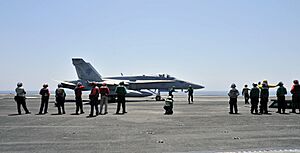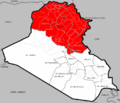US-led intervention in Iraq (2014–2021) facts for kids
Quick facts for kids US-led intervention in Iraq (2014–2021) |
|||||||||
|---|---|---|---|---|---|---|---|---|---|
| Part of the War against the Islamic State (Operation Inherent Resolve), the War in Iraq (2013–2017), Islamic State insurgency in Iraq (2017–present), and the War on terror | |||||||||
 An American F/A-18C Hornet aboard USS George H.W. Bush prior to the launch of operations over Iraq in 2014. |
|||||||||
|
|||||||||
| Belligerents | |||||||||
|
Coalition of foreign countries:
Local forces:
|
|||||||||
| Strength | |||||||||
|
United States:
5,200–6,000 troops
7,000 contractors USS George H.W. Bush carrier strike group USS Carl Vinson carrier strike group (replaced USS George H.W. Bush in late October) USS Theodore Roosevelt carrier strike group (replaced USS Carl Vinson in late March) F-15 Eagle, F-16 Fighting Falcon, F/A-18 Hornet, F/A-18 Super Hornet, AV-8B Harrier and F-22 Raptor fighter jets B-1 Lancer bomber aircraft EA-6B Prowler & EA-18G Growler electronic warfare aircraft. Boeing AH-64 Apache attack helicopters MQ-1 Predator, MQ-9 Reaper drones Australia:
400 RAAF personnel
200 special forces troops 300 regular soldiers (combined with 150 New Zealand soldiers) 6 F/A-18 Super Hornet 1 Boeing 737 AEW&C surveillance aircraft 1 KC-30A refueling plane C-130J Hercules & C-17A Globemaster transport aircraft Belgium:
6 F-16 Fighting Falcon fighters (withdrawn "due to financial constraints" in June 2015)
120 supporting troops (for the now withdrawn aircraft) 35 military advisers Canada:
600 Canadian Armed Forces personnel
100 special operations forces 6 McDonnell Douglas CF-18 Hornet 2 Lockheed CP-140 Aurora surveillance aircraft 1 Airbus CC-150 Polaris refueling tanker C-130J Hercules & C-17 Globemaster III transport aircraft Denmark:
7 F-16 Fighting Falcon fighters
1 C-130J Hercules transport aircraft 1 mobile radar station 400 troops (support, special forces and trainers) France:
1,000 armed forces
7 Dassault Rafale, 8 Mirage 2000 1 Breguet Atlantique 1 French frigate Forbin (D620) Germany:
Italy:
Netherlands:
6 F-16 Fighting Falcon fighters + 2 spare
250 supporting troops 130 trainers for the Iraqi Army 2 Patriot missile batteries and 200 supporting troops in Turkey to defend its NATO ally against cross-border attacks. New Zealand:
10 military advisers.
Spain:
300 trainers for the Iraqi Army
6 Patriot missile batteries and 130 supporting troops in Turkey to defend its NATO ally against cross-border attacks. United Kingdom:
1 Boeing RC-135 Reconnaissance aircraft
8 Tornado GR4 ground attack aircraft 2 armed MQ-9 Reaper 1 Type 45 destroyer 1 Trafalgar-class submarine (SSN) Special forces including the Special Air Service (SAS) and additional cargo aircraft and air-to-air tanker aircraft on standby in the area. |
Around 100,000 fighters (according to Kurdistan Region Chief of Staff.) |
||||||||
| Casualties and losses | |||||||||
|
70,000+ killed (end of 2017)
|
||||||||
|
Estimated 6,000+ civilians killed by Coalition airstrikes in Iraq |
|||||||||
In 2014, the United States and other countries started a military effort in Iraq. This was in response to a group called the Islamic State (IS or ISIL) that was taking over parts of Iraq. The goal was to help the Iraqi government fight against ISIL.
On June 15, 2014, then-U.S. President Barack Obama sent American forces to Iraq. They went to check on the Iraqi army and see how big of a threat ISIL was. This mission was part of a larger effort known as Operation Inherent Resolve.
Contents
How the Fight Against ISIL Began
In August 2014, ISIL launched a major attack in northern Iraq. To help stop them, the United States began sending weapons to the Kurdish Peshmerga forces on August 5. A few days later, on August 8, the U.S. started launching airstrikes against ISIL.
Many other countries joined the U.S. in these airstrikes. These air attacks worked together with ground troops from the Kurdish and Iraqi governments. By December 2017, ISIL had lost all the land it once controlled in Iraq.
Helping Iraqi Forces
Besides direct military action, the group of countries led by the U.S. gave a lot of help to the Iraqi Security Forces. This help included training soldiers, sharing important information, and providing staff. By March 2019, the cost of this support was about $3.5 billion. Over 189,000 Iraqi soldiers and police officers received training from these international forces.
Changes and Withdrawal
In January 2020, the Iraqi parliament asked U.S. troops to leave Iraq. This request came after a U.S. airstrike killed some important Iraqi and Iranian leaders. Following this, the United Kingdom and Germany also decided to reduce their troops in Iraq.
Canada also moved some of its troops from Iraq to Kuwait. However, French and Australian forces in Iraq did not agree with a full withdrawal at that time. By August 2020, the United Nations estimated that more than 10,000 ISIL fighters were still in Iraq and Syria.
The Mission Today
The main combat mission of the international group in Iraq officially ended in December 2021. However, some U.S. troops are still in Iraq. Their job now is to advise, train, and help the Iraqi security forces. They continue to support Iraq in fighting the ongoing ISIL insurgency, including providing air support and military aid.
Images for kids
-
A German Air Force Tornado ECR refuels near Mosul, November 2016
-
An Australian soldier conducts bayonet training alongside Iraqi soldiers at Camp Taji, January 2016
-
U.S. Secretary of Defense James Mattis during his visit to Iraq, 20 February 2017
-
1st Squadron, 3rd Cavalry Regiment of the U.S. Army drill with the Battelle DroneDefender in Iraq, 30 October 2018. U.S. troops anticipate ISIL units deploying drones during reconnaissance or attacks
-
French and American soldiers in support of the CJTF-OIR in Iraq, 2019. Coalition forces supported SDF advances with airstrikes and cross-border artillery from Iraq
-
Contractors load an MRAP onto a flatbed as the CJTF-OIR coalition transfers the K-1 Air Base to Iraqi security forces, 21 March 2020
-
President Donald Trump visits U.S. troops at the Al Asad Airbase in Iraq, 26 December 2018
See also
- History of Iraq
- International Conferences on Peace and Security in Iraq (2014)
- Spillover of the Syrian Civil War
- February 2015 Egyptian airstrikes in Libya
- Opération Chammal – included French operation against ISIL
- Operation Shader – included UK operation against ISIL
- Operation Okra – included Australian operation against ISIL
- Operation Impact – included Canadian operation against ISIL
- American-led intervention in Syria
- Military intervention against the Islamic State of Iraq and the Levant
- Iranian intervention in Iraq (2014–present) – separate Iranian operation against ISIL
- Genocide of Yazidis by ISIL
- Persecution of Christians by ISIL
- Iraqi insurgency (2011–2013)
- Overseas interventions of the United States
- Fall of Mosul
- Salahuddin campaign (2014–15)
- First Battle of Tikrit
- Siege of Amirli
- Battle of Baiji (October–November 2014)
- Battle of Ramadi (2014–15)
- Battle of Baiji (2014–15)
- Sinjar offensive
- Second Battle of Tikrit (March–April 2015)
- Anbar offensive (2015)
- List of wars and battles involving ISIL
- American-led intervention in the Syrian civil war, for the closely related operations in Syria
- Iraq War, for the war beginning in 2003 and ending in 2011



















